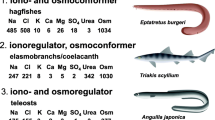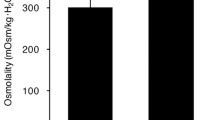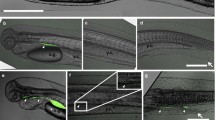Abstract
To characterize mechanisms of esophageal desalination, osmotic water permeability and ion fluxes were measured in the isolated esophagus of the seawater eel. The osmotic permeability coefficient in the seawater eel esophagus was 2·10-4 cm·s-1. This value was much lower than those in tight epithelial, although the eel esophagus is a leaky epithelium with a tissue resistance of 77 ohm·cm-2. When the esophagus was bathed in normal Ringer solutions on both sides no net ion and water fluxes were observed. However, when mucosal NaCl concentration was increased by a factor of 3, Na+ und Cl- ions were transferred from mucosa to serosa (desalination). If only Na+ or Cl- concentration in the mucosal fluid was increased by a factor of 3, net Na+ and Cl- fluxes were reduced to 30–40%, indicating that 60–70% of the net Na+ and Cl- fluxes are coupled mutually. The coupled NaCl transport seems to be effective in desalting the luminal high NaCl. The remaining 30–40% of the total Na+ and Cl- fluxes seems to be due to a simple diffusion, because these components are independent of each other and follow their electrochemical gradients, and also because these fluxes remain even after treatment with NaCN or ouabain. A half of the coupled NaCl transport could be explained by a Na+/H+−Cl-/HCO -3 double exchanger on the apical membrane of the esophageal epithelium, because mucosal amiloride and 4.4′-diisothiocyanatostilbene-2,2′-disulphonic acid inhibited the net Na+ and Cl- fluxes by approximately 30%. The other half of the coupled NaCl transport, which follows their electrochemical gradients, still remains to be explained.
Similar content being viewed by others
Abbreviations
- DIDS:
-
4,4′-diisothiocyanatostilbene-2,2′-disulphonic acid
- NMDG:
-
N-methyl-d-glucosamine
- P Cl :
-
Cl- permeability coefficient
- PD:
-
transepithelial potential difference
- P Na :
-
Na+ permeability coefficient
- P osm :
-
osinotic permeability coefficient
- TALH:
-
thick ascending limb of Henle's loop
References
Ando M (1975) Intestinal water and chloride pump in relation to seawater adaptation of the eel,Anguilla japonica. Comp Biochem Physiol 52A:229–233
Ando M (1983) Potassium-dependent chloride and water transport across the seawater eel intestine. J Membr Biol 73:125–130
Ando M, Kobayashi M (1978) Effects of stripping of the outer layers of the eel intestine on salt and water transport. Comp Biochem Physiol 61 A:497–501
Ando M, Subramanyam MVV (1990) Bicarbonate transport systems in the intestine of the seawater eel. J Exp Biol 150:381–394
Brodsky WA, Schilb TJ (1965) Osmotic properties of isolated turtle bladder. Am J Physiol 208:46–57
Burg MB, Green N (1973) Function of the thick ascending limb of Henle's loop. Am J Physiol 224:659–668
Cabantchik ZI, Rothstein A (1972) The nature of the membrane sites controlling anion permeability of human red blood cells as determined by studies with disulfonic stilbene derivatives. J Membr Biol 10:215–255
Cremaschi D, Meyer G, Botta G, Rossetti C (1987) The nature of the neutral Na+−Cl--coupled entry at the apical membrane of rabbit gall bladder epithelium: II. Na+−Cl- symport is independent of K+. J Membr Biol 95:219–228
Curran PF, Solomon AK (1957) Ion and water fluxes in the ileum of rats. J Gen Physiol 41:143–168
Diamond JM (1962) The reabsorptive function of the gall-bladder. J Physiol (Lond) 161:442–473
Diamond JM (1964) The mechanism of isotonic water transport. J Gen Physiol 48:15–42
Frizzell RA, Koch MJ, Schultz SG (1976) Ion transport by rabbit colon. I. Active and passive components. J Membr Biol 27:297–316
Frizzell RA, Schultz SG (1972) Ionic conductances of extracellular shunt pathway in rabbit ileum. Influence of shunt on transmural sodium transport and electrical potential differences. J Gen Physiol 59:318–346
Frömter E, Diamond J (1972) Route of passive ion permeation in epithelia. Nature 235:9–13
Haas M, Dunham PB, Forbush III B (1991) [3H] bumetanide binding to mouse kidney membranes: identification of corresponding membrane proteins. Am J Physiol 260: C791-C804
Hirano T, Mayer-Gostan N (1976) Eel esophagus as an osmoregulatory organ. Proc Natl Acad Sci USA 73:1348–1350
House CR, Green K (1965) Ion and water transport in isolated intestine of the marine teleost,Cottus scorpius. J Exp Biol 42:177–189
Huf EG, Parrish J, Weatherford C (1951) Active salt and water uptake by isolated frog skin. Am J Physiol 164:137–142
Kirsch R (1978) Role of the esophagus in osmoregulation in teleost fishes. In: Jorgensen CB, Skadhauge E (eds) Osmotic and volume regulation. Academic Press New York, pp 138–154
Kleyman TR, Cragoe EJ Jr (1988) Amiloride and its analogs as tools in the study of ion transport. J Membr Biol 105:1–21
Marsh DJ, Spring KR (1985) Polarity of volume-regulatory increase byNecturus gallbladder epithelium. Am J Physiol 249:C471-C475
Parmelee JT, Renfro JL (1983) Esophageal desalination of seawater in flounder: role of active sodium transport. Am J Physiol 245:R888-R893
Shi L-B, Fushimi K, Verkman AS (1991) Solvent drag measurement of transcellular and basolateral membrane NaCl reflection coefficient in kidney proximal tubule. J Gen Physiol 98:379–398
Simonneaux V, Barra JA, Humbert W, Kirsch R (1987) The role of mucus in ion absorption by the oesophagus of the sea-water eel (Anguilla anguilla L). Electrophysiological, structural and cytochemical investigation. J Comp Physiol B 157:187–199
Villegas L, Sananes L (1968) Independence between ionic transport and net water flux in frog gastric mucosa. Am J Physiol 214:997–1000
Vulliemin P, Durand-Arczynska W, Durand J (1983) Electrical properties and electrolyte transport in bovine tracheal epithelium: effects of ion substitutions, transport inhibitors and histamine. Pflügers Arch 396:54–59
Author information
Authors and Affiliations
Rights and permissions
About this article
Cite this article
Nagashima, K., Ando, M. Characterization of esophageal desalination in the seawater eel,Anguilla japonica . J Comp Physiol B 164, 47–54 (1994). https://doi.org/10.1007/BF00714570
Accepted:
Issue Date:
DOI: https://doi.org/10.1007/BF00714570




